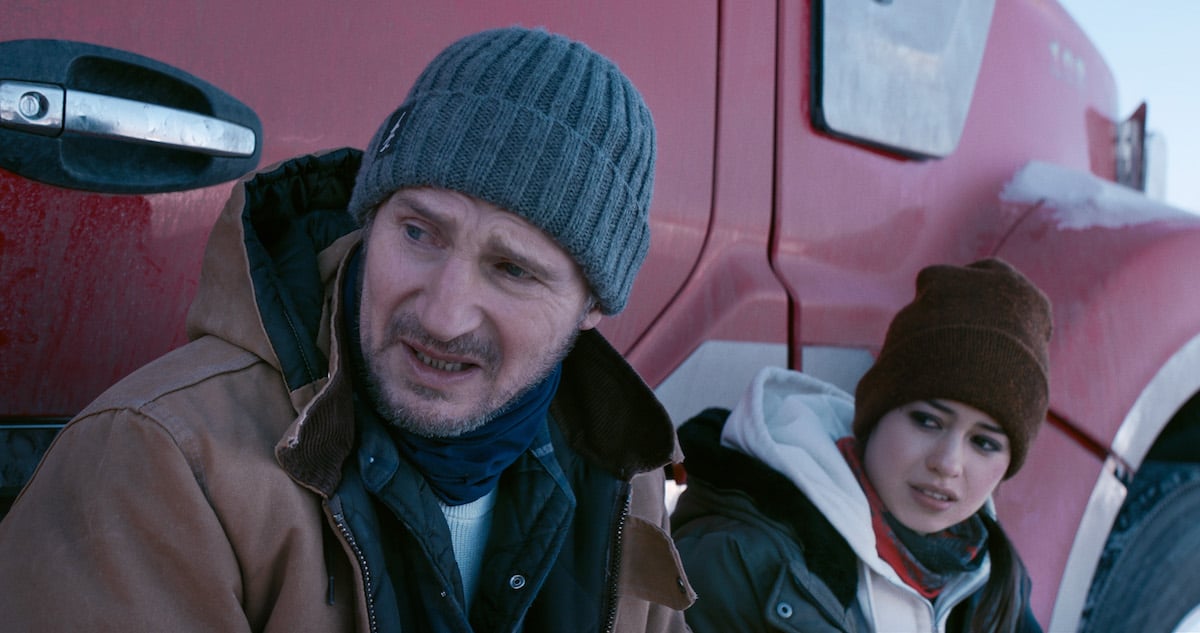Is ‘The Ice Road’ a Real Road in Canada?
Netflix debuted its original film The Ice Road on June 25, 2021. It was an action-packed spectacle with both man vs. nature and man vs. man elements. The Ice Road starred Liam Neeson, Laurence Fishburne, and Amber Midthunder. While the story is fictional, viewers have wondered: Is there a real road in Canada similar to the one on The Ice Road?
‘The Ice Road’ is an action movie that takes place on a real road

The Ice Road, starring Liam Neeson, is set in far-north Canada, where an accident caused by negligence traps several miners underground. The only equipment that can excavate the mine, and subsequently save the trapped miners, must be transported in on semi-trucks. The only way there is a treacherous road over an ice-covered river.
If that wasn’t enough, the movie also throws in greedy truckers and uncaring mining executives. Laurence Fishburne’s character delivers an odd twist that sets the movie up: If any driver dies during the delivery, then the surviving drivers get the dead one’s share of the money.
With drivers going after each other and nature itself a complication, as well as the dwindling air supply for the miners, The Ice Road delivers some edge-of-your-seat thrills, though critics panned its unrealistic story and odd pacing. IndieWire‘s review called it mildly refreshing, but said that it missed the mark by not focusing more on the actual ice road element of the story.
The story may be unrealistic, but the ice road itself is not.
The real life ice road is the safest road in North America
The real ice road is located in Canada’s Northwest Territories. The movie borrowed the ice road that services the diamond mines in the far northern parts of Canada, and the diamond mines themselves, to tell a fictional story. The actual road, though, exists.
The road is only open two months of the year, and that is when the three diamond mines bring in needed supplies and personnel. The road traverses 64 frozen lakes. (Yes, you read that right: 64 of them!) The ice has to be at a depth of at least 29 inches before it’s opened for use. Anything less than that will not bear the weight of repeated equipment and large truck crossings. That’s why it is only open during February and March; the temperatures have been low enough for enough time to freeze to the 29 inch depth.
The ice road is tested in an ingenious way: An amphibious truck is equipped with sonar to test the depth as it drives along the road. That way, if the ice breaks, the truck floats.
People are not allowed to wear seatbelts on the road, and the maximum speed limit is 15 miles per hour. It’s about 250 miles long, so the trip takes anywhere between 14 and 16 hours. Wildlife always has the right of way; the diamond mine companies are adamant about protecting it.
The actual ice road is a sight to behold, teeming with wildlife and amazing views. Authorities keep it safe and under constant monitoring. The real ice road has been named the safest road in not only Canada, but in North America.
That’s a far cry from the ice road depicted in the movie.
Truckers called the movie unrealistic
Real life truckers took to social media to air their opinions about The Ice Road, according to CDL Life.
History Channel‘s Ice Road Truckers reality stars reacted to the movie in a mostly positive way, but had a few gripes about it. Todd Dewey and Lisa Kelly pointed out how unrealistic parts of the movie were, from spacing between the trucks on the ice to how sinking into the ice was handled.
Other truckers complained on social media about inaccuracies on the trucks themselves. In some scenes, the type of truck would change. It isn’t something that general audiences would notice, but truckers saw that they were using different models for the same truck.
Truckers pointed out the inaccurate use of chains and inaccuracies in how they fueled up. Some mentioned that recovering a truck flipped onto its side on ice was nowhere near as simple as the movie made it out to be.
The consensus was that it was unrealistic. Most critics tended to agree.


